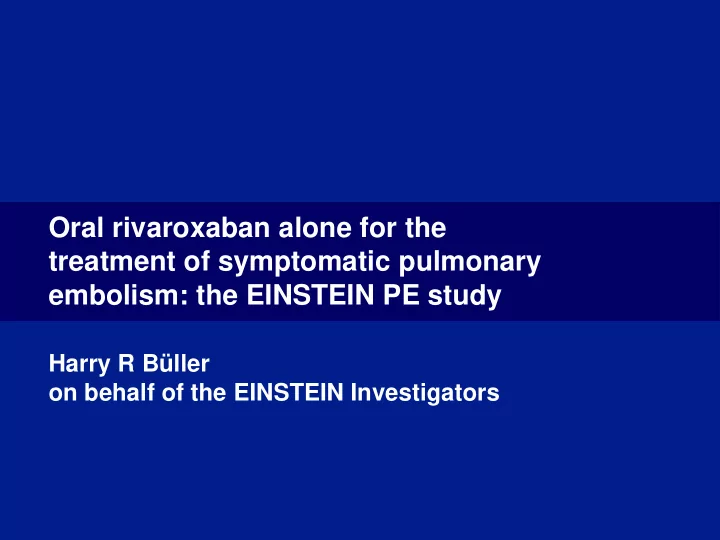

Oral rivaroxaban alone for the treatment of symptomatic pulmonary embolism: the EINSTEIN PE study Harry R Büller on behalf of the EINSTEIN Investigators
Disclosures for Harry R Büller Research Support/P.I. Sanofi-aventis, Bayer HealthCare, Bristol-Myers Squibb, Daiichi-Sankyo, GlaxoSmithKline, Pfizer, Roche, Isis, Thrombogenics Employee No relevant conflicts of interest to declare Consultant Sanofi-aventis, Bayer HealthCare, Bristol-Myers Squibb, Daiichi-Sankyo, GlaxoSmithKline, Pfizer, Roche, Isis, Thrombogenics Major Stockholder No relevant conflicts of interest to declare Speakers Bureau No relevant conflicts of interest to declare Scientific Advisory Board Sanofi-aventis, Bayer HealthCare, Bristol-Myers Squibb, Daiichi-Sankyo, GlaxoSmithKline, Pfizer, Roche, Isis, Thrombogenics
EINSTEIN PE: study design Randomized, open-label, event-driven, non-inferiority study Up to 48 hours’ heparins/fondaparinux treatment permitted before study entry 88 primary efficacy outcomes needed Non-inferiority margin: 2.0 Predefined treatment period of 3, 6, or 12 months Day 1 Day 21 Rivaroxaban Rivaroxaban N=4833 30-day Objectively 15 mg bid 20 mg od post-study R confirmed treatment PE ± DVT Enoxaparin bid for at least 5 days, period plus VKA INR 2.5 (range 2.0 – 3.0) Primary efficacy outcome: first recurrent VTE Principal safety outcome: first major or non-major clinically relevant bleeding
Patient flow Rivaroxaban Enoxaparin/VKA Randomized 2420 2413 (N=4833) 2419 2413 ITT population 2412 2405 Safety population* 2224 2238 Per-protocol population 66 Withdrawal of consent 118 Lost to follow-up 8 10 *As treated
EINSTEIN PE: primary efficacy outcome analysis Rivaroxaban Enoxaparin/VKA (N=2419) (N=2413) n (%) n (%) First symptomatic recurrent VTE 50 (2.1) 44 (1.8) Recurrent DVT 18 (0.7) 17 (0.7) Recurrent DVT + PE 0 2 (<0.1) Non-fatal PE 22 (0.9) 19 (0.8) Fatal PE/unexplained death where 10 (0.4) 6 (0.2) PE cannot be ruled out HR 0.75 1.12 1.68* 0 1.00 2.00 Rivaroxaban Rivaroxaban Rivaroxaban superior non-inferior inferior p =0.57 for superiority P= 0.0026 for non-inferiority (two-sided) (one-sided) *Potential relative risk increase <68.4%; absolute risk difference 0.24% ( – 0.5 to 1.02)
EINSTEIN PE: principal safety outcome – major or non-major clinically relevant bleeding Enoxaparin/VKA 15 N=2405 14 Cumulative event rate (%) 13 12 11 10 Rivaroxaban 9 8 N=2412 7 6 Rivaroxaban Enoxaparin/VKA HR (95% CI) 5 n/N (%) n/N (%) p -value 4 0.90 (0.76 – 1.07) 249/2412 274/2405 3 (10.3) (11.4) p =0.23 2 1 0 0 30 60 90 120 150 180 210 240 270 300 330 360 Time to event (days) Number of patients at risk Rivaroxaban 2412 2183 2133 2024 1953 1913 1211 696 671 632 600 588 313 Enoxaparin/VKA 2405 2184 2115 1990 1923 1887 1092 687 660 620 589 574 251 Safety population
EINSTEIN PE: major bleeding Rivaroxaban Enoxaparin/VKA HR (95% CI) 3.0 n/N (%) n/N (%) p -value Cumulative event rate (%) 0.49 (0.31 – 0.79) 26/2412 52/2405 2.5 (1.1) (2.2) p =0.0032 Enoxaparin/VKA N=2405 2.0 1.5 1.0 Rivaroxaban N=2412 0.5 0.0 0 30 60 90 120 150 180 210 240 270 300 330 360 Time to event (days) Number of patients at risk Rivaroxaban 2412 2281 2248 2156 2091 2063 1317 761 735 700 669 659 350 Enoxaparin/VKA 2405 2270 2224 2116 2063 2036 1176 746 719 680 658 642 278 Safety population
EINSTEIN PE: conclusions In patients with acute symptomatic PE with or without DVT, rivaroxaban showed: Non-inferiority to LMWH/VKA for efficacy: HR=1.12 (0.75 – 1.69); p non-inferiority =0.0026 for non-inferiority margin of 2.0 Similar findings for principal safety outcome: HR=0.90 (0.76 – 1.07); p=0.23 Superiority for major bleeding: HR=0.49 (0.31 – 0.79) p =0.0032 Consistent efficacy and safety results irrespective of age, body weight, gender, kidney function and cancer No evidence for liver toxicity
Recommend
More recommend